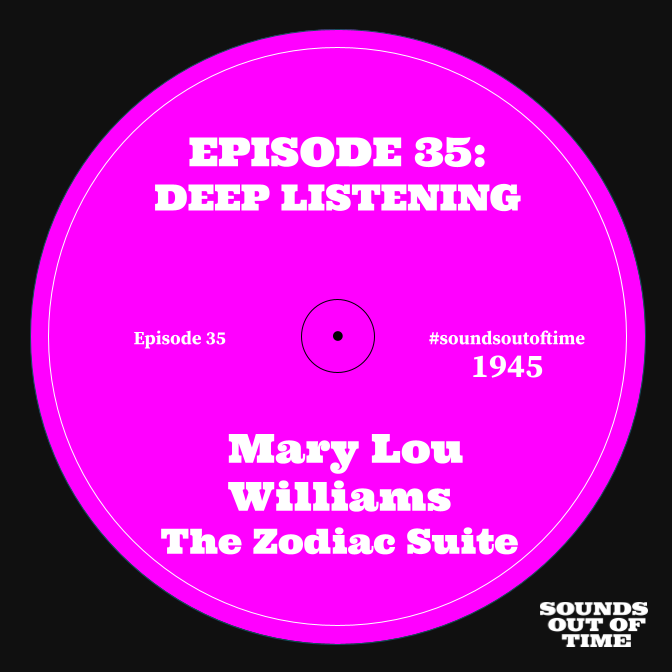(This is the edited transcript of Sounds Out of Time episode 35. Here’s a playlist that includes most of the tracks featured in the episode as well as some other worthwhile listens.)
I recently happened across a quote that really speaks to the idea behind Sounds Out of Time. A couple years ago, someone asked Marcus Moore, a senior editor at Bandcamp, how he finds new music. This was part of his answer:
“…It’s the responsibility of people who are really deep into the music to talk to their friends, spread the gospel about artists that we really like. If there’s an underground act who you really really enjoy, I feel like it’s your job to tell your friends and tell your best friend what’s so great about them or why they should be listening. That’s old school. That’s just how the gospel of the music spreads. And if we don’t do that, we’re going to have algorithms telling us what we need to be listening to.”
I’m not against the algorithm—it’s like spinning a roulette wheel that lands on a winner every so often—but it serves up the winner without any connection, context, or story. So when it comes down to it, I guess I am trying to spread the gospel of older music that matters and speak to that underground of listeners who are interested in more than just the next new thing.
Along that line, I’m excited to dive into today’s deep listening session on pianist Mary Lou Williams’s “The Zodiac Suite.” I came late to Mary Lou Williams, which is my loss. Her career mirrored all the major developments in jazz from the 1920s through the bop era and beyond. She knew and/or worked with everyone: Duke Ellington, Charlie Christian, Art Tatum, Charlie Parker, Dizzy Gillespie, Thelonious Monk, and her playing continuously evolved rather than getting stuck in a single period or style.
When her lifelong friend Duke Ellington debuted his “Black, Brown and Beige” suite at Carnegie Hall in 1943, this expanded her horizon as a composer to the possibilities of more extended works. In 1945, she wrote and premiered “The Zodiac Suite,” twelve pieces that represented each of the astrological signs. They’re each short compositions—only a couple of them are over three minutes long, and a few are under two minutes.
She performed an orchestrated version of “The Zodiac Suite” at Town Hall in New York, and she also recorded it with a trio of piano, bass, and drums. I’m going to feature that small-group recording, which was reissued by Smithsonian Folkways Records fifty years after its original release. It’s the earliest jazz trio concept album that I know of, and it has an intimacy that showcases the compositions and her playing.
It’s hard to choose among these tracks, but I’m going to feature two that give some sense of the breadth of her compositions. First up is “Virgo,” which features her playing with bassist Al Lucas. To my ear, this is the most straight-ahead piece in the suite. (clip)
Next, let’s check out something at the other end of the spectrum. Here’s “Pisces,” which starts out almost sounding like a Bernard Hermann theme from a Hitchcock film before it suddenly reveals itself as a waltz. (clip)
I love how the waltz comes out of nowhere.
“Zodiac Suite” has taken on a new life in recent years. The Mary Lou Williams Collective, featuring pianist Geri Allen, bassist Buster Williams, and drummer Billy Hart, recorded “Zodiac Suite: Revisited” in 2006. Here’s Geri Allen’s interpretation of “Libra.” (clip)
More recently, in March 2021 the New York Philharmonic performed “Zodiac Suite” with pianist Aaron Diehl. Here’s a bit of their version of “Virgo.”
There was no big cosmic message behind “Zodiac Suite,” but it did point toward Mary Lou Williams’s openness to spirituality, which emerged in full bloom a few years later. After burning out and stepping away from the music world in the mid-1950s, she converted to Catholicism and set up the Bel Canto Foundation, a nonprofit dedicated to helping drug-addicted musicians get clean.
When she started playing again, her next concept album was “Mary Lou Williams Presents Black Christ of the Andes,” a work honoring St. Martin de Porres, a Peruvian healer from the early 17th century who was canonized by the Catholic Church in 1962. In the early 1970s she wrote another longform piece called “Mary Lou’s Mass.” Miles Davis used to jokingly call her “Reverend Williams.”
Mary Lou Williams once said about her playing, “No one can put a style on me. I’ve learned from many people. I change all the time. I experiment to keep up with what is going on, to hear what everybody else is doing. I even keep a little ahead of them, like a mirror that shows what will happen next.”
The enduring popularity of “The Zodiac Suite” is a reminder that she was more than a little ahead of everybody else.
Recent inspirations:
Love Longing Loss: At Home with Charles Lloyd During a Year of the Plague (streaming for free through June 11)
Bob Dylan at 80: Rolling Stone opens its archives
“Bimini,” featuring Wayne Shorter, Jim Hall, and Michael Petrucciani at Montreux Jazz Festival, 1986 (YouTube)
Miles Davis in Berlin 1971, featuring Keith Jarrett (YouTube)
Some immortal Carla Bley tunes that everyone else wishes they’d written (Twitter via threadreaderapp)
Keith Jarrett, Dewey Redman, Charlie Haden, and Paul Motian, The Jazz Workshop, September 1974 (Tumblr).
“c'est ce qui altéra” by Sesquialtera — a cosmic brass brand (Bandcamp)
Pianist Simon Lasky: 10 tracks I can’t do without by Pat Metheny (London Jazz News)
Bill Evans, “Make Someone Happy,” from Alone (Again) (YouTube)




